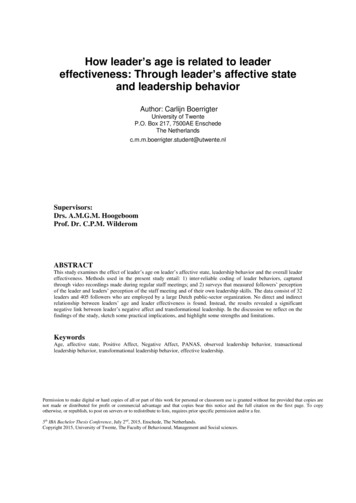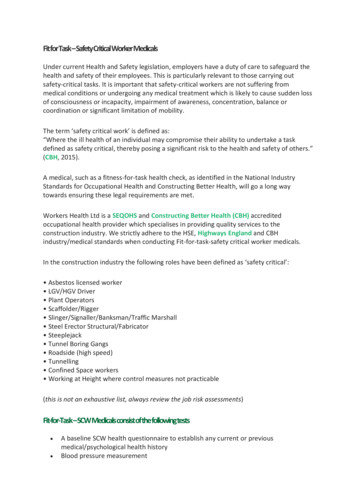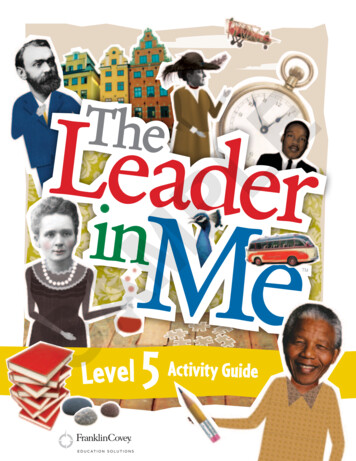
Transcription
How leader’s age is related to leadereffectiveness: Through leader’s affective stateand leadership behaviorAuthor: Carlijn BoerrigterUniversity of TwenteP.O. Box 217, 7500AE EnschedeThe rvisors:Drs. A.M.G.M. HoogeboomProf. Dr. C.P.M. WilderomABSTRACTThis study examines the effect of leader’s age on leader’s affective state, leadership behavior and the overall leadereffectiveness. Methods used in the present study entail: 1) inter-reliable coding of leader behaviors, capturedthrough video recordings made during regular staff meetings; and 2) surveys that measured followers’ perceptionof the leader and leaders’ perception of the staff meeting and of their own leadership skills. The data consist of 32leaders and 405 followers who are employed by a large Dutch public-sector organization. No direct and indirectrelationship between leaders’ age and leader effectiveness is found. Instead, the results revealed a significantnegative link between leader’s negative affect and transformational leadership. In the discussion we reflect on thefindings of the study, sketch some practical implications, and highlight some strengths and limitations.KeywordsAge, affective state, Positive Affect, Negative Affect, PANAS, observed leadership behavior, transactionalleadership behavior, transformational leadership behavior, effective leadership.Permission to make digital or hard copies of all or part of this work for personal or classroom use is granted without fee provided that copies arenot made or distributed for profit or commercial advantage and that copies bear this notice and the full citation on the first page. To copyotherwise, or republish, to post on servers or to redistribute to lists, requires prior specific permission and/or a fee.5th IBA Bachelor Thesis Conference, July 2nd, 2015, Enschede, The Netherlands.Copyright 2015, University of Twente, The Faculty of Behavioural, Management and Social sciences.
1. INTRODUCTIONEffective leadership is an important factor for organizationalsuccess. Especially within the field of leadership, behavior iswidely regarded to be one of the most influential factors. Animportant classification or behavioral taxonomy is that ofAvolio (1999) and Bass (1998); the transactionaltransformational leadership theory. Transactional leadersmotivate their followers to fulfil their leaders’ expectations byrewarding and monitoring followers’ task executions (Burns,1978). Transactional leadership behavior is similar to taskoriented behavior (Yukl, Gorden & Taber, 2002). Task-orientedleadership reflects behaviors focused on promoting efficient andeffective task accomplishment, clarifying, explaining andinforming (Yukl, 2013). In contrast to transactional behavior,there are also leaders who show transformational behaviors(Yukl, 2013). Transformational leaders inspire followers towork for collective goals and move beyond their own selfinterests. Transformational behavior relates to relation-orientedbehavior (Bass, 1990). This leadership behavior tries tomotivate and stimulate their followers to perform well.Relation-oriented leadership reflects behaviors that display theurgency of interpersonal relationships (e.g., treating followersas equals, being friendly and approachable; Yukl, 2013). Yukl’staxonomy shows convincingly that leaders’ relation-orientedand task-oriented behaviors are both important and should beincluded when studying leader behaviors in organizationalsettings such as regular staff meetings.Apart from leader behavior, which has been found to be animportant determinant for leadership effectiveness in theliterature, age is considered to be another importantdeterminant. Drawing upon the early trait theories (Bass, 1990;Stogdill, 1948), a leaders’ chronological age is one of the mostimportant demographic factors in relation to effectiveness.Particularly noteworthy is the relation between the age ofworld’s greatest political leaders and the world’s greatestpolitical revolutionaries. The group ‘world’s politicalrevolutionaries’ is characterized predominantly by youngerindividuals rather than older ones, while nearly all politicalleaders achieve top political positions over the age of 40. Inaddition, most nascent entrepreneurs tend to be younger than 35whereas the median age for the CEO’s of Fortune 500companies is 55 (Blondel, 1980; Korunka, Frank, Lueger, &Mugler, 2003; Rejai & Phillips, 1979). The patterns mentionedabove, show that both younger and older leaders are effective intheir own field. Therefore, leader effectiveness is interesting tostudy with a wide variance in age.The study of leadership behavior and age is interesting forseveral reasons (Zacher & Frese, 2009). For instance,demographic changes (i.e., the anticipation of longer workinglives results in an outlook of a rapidly aging workforce) haveled to an increased interest in the study of leadership behaviorand age (Farr & Ringseis, 2002; Kanfer & Ackerman, 2004).Therefore, studying leadership in relation to age is also ofpractical importance for organizations. Older workers remainemployed longer (due to changing political regulations) anddeclining birth rates have dramatically increased the share ofolder employees (Hedge, Borman & Lammheim, 2006).Accordingly, issues surrounding the management of an agingworkforce are beginning to take center-stage in many areas oforganizational research (Hedge & Borman, 2012). Moregenerally, Schaie and Wilis (2011) studied the psychologicaleffects of aging. From a leadership perspective, the mostinteresting findings in this literature are that an individual’s agehas consequences for their emotional functioning and affectivestate (Scheibe & Zacher, 2013). Because leadership isinherently an emotional phenomenon, age may decisivelyinfluence key aspects of leadership, such as the behavior thatthey show (Ashkanasy & Tse, 2000; George, 2000). With this,we examine the effect of leaders’ age on their positive affectiveand negative affective state.Zacher, Rosing and Frese (2011) conclude that “leadershipresearchers have hardly considered age as a substantialconcept” (p. 43). Current studies about leaders’ age andleadership behaviors have shown mixed results (DeRue,Nahrgang, Wellman & Humphrey, 2011). Moreover, incontemporary research leaders’ age has featured as controlvariable (Walter & Scheibe, 2013). During this study, we testedthe direct effect of age on leader effectiveness and examined theindirect effect of leaders’ age on leader effectiveness, mediatedby leader affective state and leadership behavior. Besides that,DeRue et al. (2011) designed a classification scheme whichsummarized studies that linked age and leadership behavior.Most studies in this classification scheme rely only onquantitative survey measures (Hit & Tyler, 1991; Barbuto,Fritz, Matkin, & Marx, 2007; Ng & Sears, 2012). Based on thisscheme, Walter and Scheibe (2013) developed a novel,theoretical, emotion-based framework that explained ageleadership behavior linkages. They have integrated theories ofemotional aging with research on emotions and leadership, butempirical work is missing. We bridge this gap by empiricallytesting leadership behavior with leaders’ age and their affectivestate.Furthermore, there is hardly any literature linking age andleader affective state. Joseph, Dhanani, Shen, McHugh,McCord, (2015) examined in their meta-analysis therelationship between leader trait affectivity and leadershipcriteria such as transformational leadership, transactionalleadership and leadership effectiveness. The analysis of Joseph,Dhanani, Shen, McHugh and McCord (2015) does not addressthe variable ‘age’ with leader trait affect and leadership criteria.Through our present study we aim to contribute to the extantliterature by examining whether leadership effectiveness isinfluenced by age. In order to do this, we will assume a researchmodel of leaders’ age and leadership effectiveness and examinewhether two additional variables, leaders’ affective state andleadership behavior, mediate this relationship. In the appendix,a figure is added which contains the research model.So the research question is: “What is the influence of leader’sage on leadership effectiveness and how mediate leader’saffective state and leadership behavior this relationship? “Furthermore, the present study differs among others through theuse of a video observation method. The behavior of leaders andtheir followers during regular staff meetings will be observedand coded using a behavioral coding scheme. Few existingstudies used such observational methods.2. THEORY AND HYPOTHESESAccording to the psychological literature, researchers suggestthat age relates to leadership in a complicated way. Evidencefor the relation between age and leadership can be found inprofessions that require a substantial amount of specializedknowledge and experience, such as in science, politics, and arts(Van Vugt, 2006). As previously noted, it is commonlybelieved that age and experience may play important roles inthe behaviors that leaders display. However, most studies onage and leadership are limited to either retirement oradolescence (Barbuto, et al., 2007). In this section, we set outtheoretical background of age, leaders’ affective states andleadership behavior. First, we discuss the trait variable ‘age’.Second, we set out positive and negative affective states and
examine the relationship of age and affective states. After that,we set out the different leadership behaviors (transactionalleadership behavior and transformational leadership behavior)and examine the relationship between affective state andleadership behavior and the relationship between age andleadership behavior. Following that we shall propose howeffective leadership might be related to transactional ortransformational-oriented leadership behavior. In the appendix,an illustrated hypotheses scheme is added.2.1 AgeStyles of leadership may vary based upon age. Cagle (1988) hasemphasized that age is one of the most important factors thatdetermine the leadership style. It is commonly believed that ageand experience are important contributors when determiningwhich behavior a leader displays. Ahiazu (1989) suggests thatin many cultures people see experience as a function of age.Emotional aging research has identified common changes in theemotional experience which influence behavior. These changesconcern specific gains and losses in individuals’ affectivity(Watson & Naragon, 2012). Walter and Scheibe (2013) arguedthat such changes can influence leaders’ behaviors andoutcomes and, thus, may serve as mediating mechanismsbetween age and leadership behavior. In our research we linkthe developments of emotional aging; which is a dependentoutcome of age, toward leaders’ positive and negative affectivestate. In the current research we focus on chronological age.Schalk et al. (2010) identified chronological age as “the firstand primary conception of age” (p. 79). In this study we focussolely on chronological age, as the measure of leaders’ ageconsisted only of one question in our survey such as: ‘How oldare you?’2.2 Positive affect and negative affectWatson, Clark and Tellegen (1988) presented a two-factor –positive affect and negative affect – model. This so-called‘PANAS schedule’ consists of positive and negative affectscales and is considered to be reliable and valid. The positiveaffect and negative affect scales represent affective statedimensions. The following ten sufficient descriptors for positiveaffect scale are developed in the PANAS method: attentive,interested, alert, excited, enthusiastic, inspired, proud,determined, strong and active (Watson, Clark & Tellegen,1988). High positive affect is a state of high energy, fullconcentration, and pleasurable engagement (Watson &Tellegen, 1985). This kind of state reflects stable individualdifferences in positive emotional experience (Watson &Naragon, 2009). Positive affect is associated with top-downprocessing used in response to familiar and kindlyenvironments. This means that positive affect used heuristicapproaches that rely on existing knowledge and assumptions(i.e., in the field of organizational decision making) (Forgas &Bless, 2006).In contrast, negative affect is a general dimension of subjectivedistress and unpleasable engagement that expresses a variety ofaversive mood states, including anger, contempt, disgust, guilt,fear, and nervousness. The PANAS method developed tensufficient descriptors for negative affect scale. These ten finalversions consisted of two terms from each of the other fivetraits: distressed, upset (distressed); hostile, irritable (angry);scared, afraid (fearful); ashamed, guilty (guilty); and nervous,jittery (jittery). Tellegen (1985) suggested that high negativeaffect is a major feature of anxiety and depression. Negativeaffect is related to self-reported stress and coping (Clark &Watson, 1986). Negative affect is associated with bottom-upprocessing in response to unfamiliar or problematicenvironments, and promotes controlled approaches that rely onexternally drawn information (Forgas & Bless, 2006).Also positive affect and negative affect are related to individualdifferences in positive and negative emotional reactivity(Tellegen, 1985; Watson & Clark, 1984). Positive affect andnegative affect correspond to the dominant personality factorsof extraversion and anxiety, and are related to individuals’emotional experience (Tellegen, 1985; Watson & Clark, 1984;Watson & Naragon, 2012). Another important finding is thatresearch has identified that positive affect is relativelyindependent from negative affect (Watson & Clark, 1984).Other scholar also mentioned this, for instance Thompson(2007). In his qualitative and exploratory quantitative study hedeveloped and validated a short-form of the PANAS schedule.Thompson (2007) reported positive affect and negative affectwith low correlating dimensions. Also Bradburn (1969)demonstrates that the two affect dimensions were independentof one another. Hence, scores on one affect dimension did notpredict the score on the other affect dimension: therefore,positive and negative affect was not an extreme pole of oneunderlying dimension, but of two separate dimensions.Therefore, in this study the two affective state dimensions arediscussed independently of one another, and we discuss howthey are related to age and leadership behavior.2.2.1 Relation between age and affective stateExisting studies have found significant age effects on leaders’affective state and overall effectiveness. Surprisingly, there arecomplex and contradictory pattern of findings (Walter &Scheibe, 2013). Doherty (1997), for example, reported thatyounger leaders were perceived as more effective than olderleaders. In contrast, Shore, Cleveland and Goldberg (2003)found that leader age and follower satisfaction were positivelyrelated among older followers but negatively related amongyounger followers. Overall, studies regarding the relationbetween positive and negative affect and age predict that aspeople get older, they are increasingly motivated to experiencepositive feelings and avoid negative feelings (Scheibe &Zacher, 2013). This assumption is supported by other work. Forinstance, Blanchard-Fields (2007) argued that older individualsrepeatedly encounter emotional situations and so they learn tobetter comprehend and resolve such events. Besides that, olderindividuals can predict the emotions elicited by future eventsmore correctly. Löckenhoff, O’Donoghue and Dunning (2011);Scheibe, Mata and Carstensen (2011) report that olderindividuals have higher control of their emotions. Also, otherrecent studies have shown that older individuals’ daily emotionsare more positive and stable compared to younger individuals’(Scheibe, et al., 2011; Riediger, Schmiedek, Wagner, &Lindenberger, 2009). This implies that older leaders’ shownmore positive affect. This development is mainly driven by areduction in high-arousal negative affective state (e.g., anger)and an increase in low-arousal positive state (e.g., contentment)whereas low-arousal negative affective state (e.g., sadness) andhigh-arousal positive affective state (e.g., enthusiasm) remainrelatively unchanged (Scheibe, English, Tsai, & Carstensen,2013; Stone, Schwartz, Broderick, & Deaton, 2010). Anotherimportant finding is that older individuals prioritize positiveinformation over negative information (Reed & Carstensen,2012) and therefore pay greater attention to positive versusnegative social cues, which positively affects the display ofpositive affective emotions (Kellough & Knight, 2012).As mentioned in the previous paragraph, negative affect isassociated with bottom-up processing in response to unfamiliaror problematic environments. Younger leaders are lessexperienced and therefore more dependent upon outsideinformation with controlled approaches that relies on externally
drawn information (Forgas & Bless, 2006). This resultcontributes to the prediction that younger leaders show morenegative affective state. Hence, we propose the followinghypotheses:H1a: An older leader displays more positive affective state.H1b: A younger leader displays more negative affective state.2.3 Leadership behaviorIn the past half century, hundreds of survey studies haveexamined the correlation between leadership behavior andvarious indicators of leadership effectiveness (Bass, 1990;Yukl, 2002). A major problem in research and theory oneffective leadership has been the lack of agreement about whichbehavior categories are relevant and meaningful for leaders(Yukl Gordon & Taber, 2002). Scholars are aware of howdifficult it is to compare and integrate results from studies thatuse different sets of behavioral categories. Occasionally,different terms have been used to refer to the same type ofbehavior. At other times, the same term has been defineddifferently by various theorists. Based on previous observationsin an existing study (Rackham & Morgan, 1977), a leadershows various activities in a group context. These activitiesinclude: ‘seeking information, giving information, testingunderstanding, summarizing, procedural proposals, contentproposals, supporting, disagreeing, defending/attacking andbuilding’. Hence, when examining leader behavior, it istherefore important to take into account the so-called “fullrange” of leadership behavior (Bass & Bass, 2008; Avolio,Bass, & Jung, 1999; Bass, 1985; Bass & Avolio, 1994). The fullrange of leadership behavior consists of three general types management by exception, passive management by exception),transformational (individual consideration, idealized influence,intellectual stimulation, and inspirational motivation) andlaissez-faire. This full range model was developed to broadenthe range of leadership styles typically investigated in the field.It is necessary to measure the validity of the full range ofleadership behaviors. Bass (1985) developed ‘the MultifactorLeadership Questionnaire (MLQ)’. The MLQ measured bothtransactional and transformational leader behavior. It includesthe complementary dimensions of transformational andtransactional leadership with sub-scales to further differentiateleader behavior. Also Yukl (2012) developed an instrument,namely, the 2-factor ‘task-versus relation oriented behaviormodel’. Yukl’s and Bass’ leader behavior models overlap eachother in the leadership literature. Therefore, in our study weexamine transactional versus transformational leadershipbehavior.2.3.1 Transactional leadership behaviorBass (1990) characterizes a transactional leader as one whichfocuses on transactions between leaders and employees. Thistransaction includes: “The transaction of promising and rewardfor good performance, and on the other hand threatening anddisciplining for poor performance” (p. 20). The leader getsthings done by making and fulfilling the promises ofrecognition. Prominent examples include initiating structure(e.g., clarifying task roles, coordinating followers’ actionsstructure and structuring the conversation). Two dimensionsthat characterize transactional leadership style are contingentreward and management-by-exception (active and passive).Contingent reward consists of offering rewards for goodperformance and effort. Employees receive incentives after theyaccomplish their tasks to stimulate their task motivation.Management by exception is split up into two forms. The activeform consists of watching and searching for deviations fromrules and standards and takings corrective action (i.e., activelymonitoring before mistakes are made). Passive management byexception is shown after standards are not met (i.e., correctingafter mistakes are made). In the passive form, the leader doesnot give direction if the old ways are satisfying and followersstill achieve the performance goals (Hater & Bass, 1988). Bassand Riggio (2006) suggest leaders with a large span of controlused management by exception passive more often. Bass andRiggio (2006) suggest that some behaviors lead to morecommitted, loyal and satisfied followers than others. AlsoWaldman, Bass and Yammarino (1990) showed in their studythat contingent reward behavior can be seen as the basis ofeffective leadership. Contingent reward is transactional whenthese incentives are material (e.g., bonus). These findings arealso established by Bass and Avolio (1994). In their full rangeof leadership model, contingent reward leadership was the onlyleadership behavior that was seen as effective. More ineffectivecompared with contingent reward is management by exception.Bass and Avolio (1994) showed that leaders who usemanagement by exception lack both inspirational appeal andmotivational power.Since transactional leadership is based on the concept ofexchange, whereby the leader engages in monitoring followeractivities, task monitoring can be seen as a key transactionalleader behavior (Bass, 1990). Besides the rewarding behavioraldimension of transactional leadership behavior, Judge andPiccolo (2004); Lowe, Kroeck and Sivasubramaniam (1996)and Podsakoff, Bommer, Podsakoff, and MacKenzie, 2006)have highlighted the importance of task monitoring inleadership. Hence, we linked transactional leadership with taskoriented leadership behavior. Yukl et al. (2002) founds thattransactional leadership include some task behaviors. Thesetask behaviors include: short-term planning, clarifyingresponsibilities and performance objectives and monitoringoperations and performance (Yukl et al., 2002). Hogdgson(2004) noted that task-oriented style leads to relative goalstability with active planning and structuring. Followers knowwhat is expected of them and they clearly understand themessages and goals to be reached (Putman and Sorenson,1982). This is a main objective of the transactional leadershipstyle.2.3.2 Transformational leadership behaviorScholars have introduced the concept of transformationalleadership. House (1977) has published an article ontransformational leadership, Burns (1978) write abouttransformational leadership, and Bass (1985) published hisbook ‘Leadership and Performance beyond Expectations’. Animportant insight is that Bass (1985) differs from Burns’ work.Burns (1978) viewed transactional and transformationalleadership as opposites ends of the same continuum and leaderscould only be transformational if results and goals are satisfied.Bass (1985) noted that “most leaders do both but in differentamounts” (p. 22). He argued that transactional leadershipprovides the base for effective leadership and performance atexpected standards, while transformational leadership leads toperformance beyond expectations. Hence, transactional leadersensure that expectations are met, which is the foundation onwhich transformational leaders build to motivate their followersto perform beyond expectations. This opinion is shared in otherwork (e.g., Burns, 1978; Trottier, Van Wart, and Wang 2008).Hater and Bass (1988) and Howell and Avolio (1993) haveshown that the more effective leaders are both transactional, ina path goal sense, and transformational, which is referred to as‘the augmentation effect’. This effect assumes that thetransformational leadership style is expected to be ineffectivewithout a transactional relationship between leader and follower(Bass, Avolio & Goodheim, 1987). Therefore, transactional
leadership behavior adds to the effectiveness of a leader with atransformational leader behavior (Bass, Avolio, Jung, &Berson, 2003; Hater & Bass, 1988; Bass, 1985; Wofford &Goodwin 1994).Bass (1990) defined transformational leadership as “superiorleadership” (p. 21). Transformational leadership ischaracterized by the four l’s: Idealized influence, inspirationalmotivation, individual consideration and intellectualstimulation. Idealized influence means that followers identifywith their leaders and respect and trust them. Inspirationalmotivation refers to creating and communicating an attractivevision of the future and to the leaders’ own optimism about thisfuture. These behaviors are important in motivating followers touse their capabilities for collective goals and emphasizingcollective identities. Individual consideration means that leadersare mentors for followers and that they have attention for thefact that every follower had his or her own needs and abilities.Thereby, leaders enhance the personal development offollowers (Bass et al., 2003). Individualized consideration isrecognized by several leadership scholars as a key factor ininfluencing follower satisfaction as well as high performanceoutcomes (Bass & Bass, 2008; Gardner, Avolio, Luthans, May,& Walumbwa, 2005; Schriesheim, Wu & Scandura, 2009;Yukl, 2006). The reason for this isat leaders who showindividualized consideration address the uniqueness ofindividuals. This results in progressing individual potency.Finally, intellectual stimulation refers to challenging followersto rethink some of their ideas and to take a different perspectiveon the problems they face in their work. Hereby, new thinkingpatterns are encouraged (Avolio & Bass, 2004).Leaders who applied transformational leader behavior may becharismatic to their followers and thus inspire them. Besidesthat, they may meet the emotional needs of each employee andthey may therefore intellectually stimulate followers (Bass,1990). Charismatic leaders inspire and excite their employeeswith the idea that they may be able to accomplish great thingswith extra effort. Therefore, charismatic leadership is a centralsucceeding characteristic.2.4 Relation between age, leader affectivestate, leadership behaviorIn the previous paragraphs we explored the effects of positiveaffective state and negative affective state on leaders’ age andwe discussed the two main leadership behaviors; transactionalleadership behavior and transformational leadership behavior.In this paragraph we connect leader affective state andleadership behavior to each other. Subsequently, we relateleadership behavior to age.2.4.1 Relation between positive and negativeaffective state and leadership behaviorJoseph et al. (2015) noted that the role of leader affective stateis a meaningful predictor of leadership behavior. In their metaanalysis, Joseph et al. (2015) studied the relationship betweenleader trait affectivity and several leadership criteria (includingtransformational leadership, transactional leadership andleadership effectiveness) and found that the relationshipbetween leader’s affectivity states and leadership effectivenessoperates through transformational leadership. Transformationalleaders display positive emotions to communicate a vision,motivate followers and elicit positive behavioral change (Rubin,Munz & Bommer, 2005). Bass and Avolio (1994) also sharedthis view by suggesting that leader’s positive emotionaldisplays (a characteristic of transformational behavior) fosterhigh quality follower relationships and engender positiveemotions in followers. Relevant to the current study, thescholarly literature on leader affect and leadership behaviorsuggests that leaders who score high on positive affect oftendisplay positive affective state which also influence followerpositive affective state (Bono & Ilies 2006; Eberly & Fong2013; Johnson, 2009; Newcombe & Ashkanasy, 2002; Sy, Côté& Saavedra, 2005). This process is the so-called moodcontagion processes. The relationship between leader’s positiveaffective state and leadership criteria (i.e., leadership behavior)proposed a positive relationship that is driven by this moodcontagion processes. This process suggests that positive affectof the leader influences followers’ positive affective state thatsubsequently results in leadership effectiveness. Thus, as notedby George and Brief (1992), ‘leaders who feel enthusiastic andenergetic themselves are likely to similarly energize theirfollowers, whereas leaders who feel distressed and hostile arelikely to negatively activate their followers’ (p.84). Recentlyscholars (Gaddis, Connelly & Mumford, 2004; Lewis, 2000 andNewcombe & Ashkanasy, 2002) argued that leaders whoexpress positive affect are perceived as more effective andcharismatic than those who do not. Hereby, the expressions ofpositive affect can be seen as one of the specific behaviorindicators of charismatic leadership (Bass, 1985). Charisma is acentral point in transformational leadership. Damen,Knippenberg and Knippenberg (2008) have also supported nsformational leadership behavior. In their scenarioexperiment, Damen, Knippenberg and Knippenberg (2008)found that charismatic leaders display more positive emotions.Bono and Ilies (2006) have supported this point as well.Moreover, Avolio andBass (2002) mentioned thattransformational leadership behavior consists of affect-relatedcontent (e.g., displays of optimisms), while a leader who showstransactional leadership behavi
leadership behavior and the relationship between age and leadership behavior. Following that we shall propose how effective leadership might be related to transactional or transformational-oriented leadership behavior. In the appendix, an illustrated hypotheses scheme is added. 2.1 Age Styles of leadership may vary based upon age.










